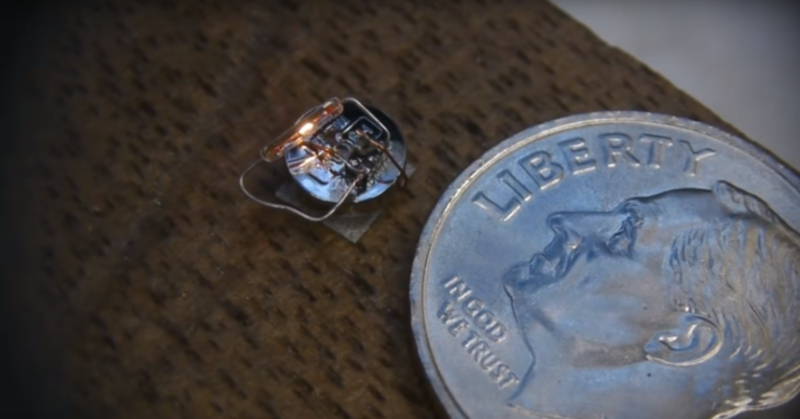We’re going to go out on a limb here and declare this minuscule incandescent light flasher the smallest such circuit in the world. After all, when you need a microscope to see it work, you’ve probably succeeded in making the world’s smallest something.
Even if it’s not record breaking, [Ben Krasnow]’s diminutive entry in the 2017 Flashing Light Contest, which we recently covered, is still pretty keen. For those not familiar with the contest, it’s an informal challenge to build something that electrically switches an incandescent light on and off in the most interesting way possible for the chance to win £200. [Ben] says he’ll donate the prize money to a STEM charity if he wins, and we’d say he has a good chance with this flea-sized entry.
The incandescent lamp he chose is a specialty item for model makers and scale railroad enthusiasts; we’d heard of “grain of wheat” bulbs before, but this thing is ridiculous. The bulb makes the 4.6 mm diameter SR416 hearing aid battery that powers the flasher look enormous. The driver is a clever Schmitt trigger inverter with a tiny RC network to flash the bulb at about 1 Hz. The video below shows the flasher working and details the development and the build, which featured spot welding to the battery. [Ben] has even spec’d precisely how many Joules of energy will rupture the thing steel cases on these cells — we suspect involuntarily through trial and error.
[Ben]’s entry in the contest is now our favorite, and not just because he’s been a great friend to Hackaday with such classic hacks as watching a phonograph needle with an electron microscope and a homebrew CT scanner. This circuit is genuinely fascinating, and we hope it inspires you to try to top it. There’s a little less than a month left in the contest, so get to it.
















pretty neat. are those bulbs smaller than what we’d find in certain digital watches?
I think they are exactly the watch bulbs. Although there are two sizes: This linear one with less than 1mm diameter and a miniature bulb one, around 1mm diameter and a length of around 2,5 to 3mm.
What is this? Flashlight for the ants? :D
Should’ve used a 555 (instead of a quarter, for scale!)
That dime is a lot smaller than a quarter.
Wow, so it is!
A dime is 40% of a quarter which means it’s 60% smaller (by value). I wonder if it’s the same ratio in terms of area or diameter.
It is handy to have the gear to be able to categorise the actual parts you have, you can then drop their parameters into a simulator and design or even evolve circuits with them, which would otherwise be very difficult with nonlinear analogue parts.
Has anybody in this contest tried just putting a thermal switch (bimetallic strip) in series and pressing it to the bulb? It could be pretty tiny, it’s one part, and it’s how turn signals used to work.
Here: https://i2.wp.com/upload.wikimedia.org/wikipedia/commons/e/e6/Blinkgluehlampe_Bimetall_animated.gif
Built-in. :)
Christmas light blinkers are the same http://people.howstuffworks.com/culture-traditions/holidays-christmas/christmas-lights2.htm
sorry that u need a heat gun to run the system …
…
may be u can make a tiny heat gun ..?
It works without the heat gun, its just quite dim.
I’ve done RF circuits this size before.
Well, now someone has to go big…
Has [Photonicinduction] heard about this contest yet? ;)
Does making your whole neighbourhood’s subsystem blink count?
Hahaha, absolutely!
Nice, but I much prefer a blog format rather than having to scan through several minutes of video to find things like schematics.
Same here. And hackaday.io is one of the best ways to do it.
Ohh the old “wheat of grain” bulbs
http://s.click.aliexpress.com/e/qfEYNZ7
used in scale models, toys and architectural mockups
Ohh the old stupid Absolutysomething that is still spamming.
HaD: Don’t you have a blacklist? Put this click-stuff onto.